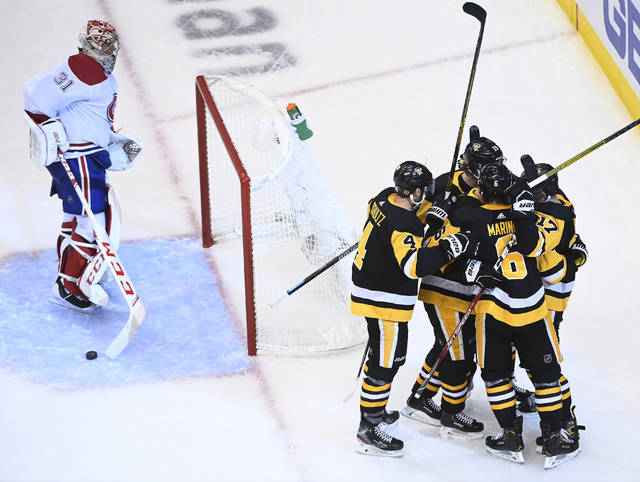Penguins adjust to peculiar trend of increased penalties during playoffs
In 2020, seemingly everything is weird or backward.
So why not the conventional wisdom regarding officiating in the Stanley Cup playoffs, too?
The standard operating procedure for hockey postseasons typically involves referees who overlook infractions as part of a “let them play” philosophy.
Then again, the standard operating procedure for hockey postseasons typically involves fans in arenas, home-ice advantage and a spring schedule. The latest peculiarity for the 2020 race for the Cup is officials who have been much more open to giving teams power-play opportunities.
“It’s been an adjustment. That’s for sure,” Pittsburgh Penguins defenseman Kris Letang said between Games 2 and 3 of a qualifying-round series against the Montreal Canadiens. “Especially in the first two games, a lot of power plays, a lot of penalty kill.”
There have been 11 minor penalties called during each of the first two games in the Penguins-Canadiens series — nine power plays in each contest — plus a pair of penalty shots in Game 1.
That is part of a leaguewide trend during this postseason. In the 22 games in the Toronto and Edmonton “bubbles” through Tuesday, there were 176 power plays — an average of eight per contest. That is up 35% from the regular-season average of 5.94 power plays per game, according to hockey-reference.com.
Plenty of theories abound as to why so many penalties are being called. Are the referees rusty? Are they trying to establish an authority? Has the league instructed them to call things tighter?
Or are the players still finding their way after 4 ½ months off ? Maybe they have so much pent-up energy they’re playing too aggressively?
“Not really sure as to why that is,” said Teddy Blueger, the Penguins’ top penalty-killer by ice time.
“You just adjust and try to manage the energy and stay kind of ready to go (on special-teams duty) at any given moment.”
No one understands that more than Letang, the only Penguins player in the top five on the team in average ice time for both penalty kill and power play. Letang sounds equally flummoxed.
“Maybe it’s the fact we are jumping right into the playoff (after a long layoff), and it’s kind of maybe tough to start that way,” Letang theorized. “Maybe that’s why people are maybe on edge? I don’t know. But all I know is we’ve got to go out there and just have to play the game.”
. @MarkMaddenX: #Penguins determined to travel most difficult path possible https://t.co/ug4zjGtTlE
— Tribune-ReviewSports (@TribSports) August 5, 2020
The Penguins are among the least-penalized teams. Only one of the other 15 teams in a qualifying-round series (Florida) has given its opponent fewer power plays per game than the Penguins (2.5).
But the Penguins are doing their part by drawing penalties. They have been awarded 12 power-play opportunities through two games and have enjoyed an average of 10 minutes, 42 seconds of man-advantage time per game. That’s the highest figure among the 24 postseason teams.
“The referees are calling the penalties, so they are calling what they see,” Penguins coach Mike Sullivan said. “And that’s their responsibility. So I am sure there are lots of theories on why that is at this time of year, and I think the obvious one is that most guys haven’t played in a while, so everybody is trying to capture their game as we play here.”
Sullivan said discipline has been emphasized with his team, which allowed an average of 3.06 power plays per game during a regular season that across the league featured the second-fewest power plays per game in NHL history.
Whether the inverse of that continues, it’s always smart to work on limiting penalties.
“We will see how it goes moving forward, but all we can do is just play through that process,” Sullivan said. “We have worked a fair amount of our special teams trying to get better in that aspect of our game, and we think we are making progress there.”
Chris Adamski is a TribLive reporter who has covered primarily the Pittsburgh Steelers since 2014 following two seasons on the Penn State football beat. A Western Pennsylvania native, he joined the Trib in 2012 after spending a decade covering Pittsburgh sports for other outlets. He can be reached at cadamski@triblive.com.
Remove the ads from your TribLIVE reading experience but still support the journalists who create the content with TribLIVE Ad-Free.

